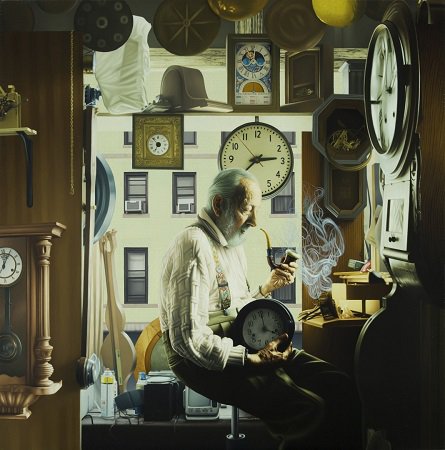
Max Ferguson, b. 1959
Time, 2006
Oil on panel
Crystal Bridges Museum of American Art, Bentonville, Arkansas
To sooth the pain of our first Monday of Daylight Saving Time, we turn our bleary, red-rimmed and tired eyes to Max Ferguson’s masterful painting, Time.

Max Ferguson “Time,” 2006 Oil on panel 36 x 36 in. © Max Ferguson. Crystal Bridges Museum of American Art, Bentonville, Arkansas. Photography by Edward C. Robison III.
Ferguson captures quiet, everyday moments of everyday people, often in and around New York City, with astonishingly realistic precision. The works are evocative, nostalgic, and affecting, and have been compared to a marriage of Vermeer and Hopper. Often categorized as a “photo-realist,” the artist disavows the title. Unlike traditional photo-realists whose work is created through the projection of a single photographic image onto canvas to be faithfully rendered, Ferguson’s paintings evolve out of several photographic studies of locations and models that he then composes into a single, usually small-scale, painting. Time, at 36 x 36 inches, took seven months to complete, and has a particularly fascinating story. In an essay Ferguson wrote about the painting, he describes what he later learned about the model.
As it turned out, his name was Knud Maastrand Christiansen. He had been a member of the Danish rowing team in the infamous 1936 Olympics in Berlin. In 1943, during the German occupation of Denmark, when word got out that Germany was about to round up all its Jewish citizens for deportation to concentration camps, many Danes worked to transport all the Jews on boats to Sweden. Not only was Mr. Christiansen one of those who literally rowed people to safety in Sweden, but he and his wife were the main organizers of the effort. Thousands of people owed their lives to him and his wife. When I found this out, I could not stop shaking his hand.
You can read more about Knud Christiansen in this article from The Jewish Week in 2011. Christiansen passed away in New York in February, 2012, at age 97.
I interviewed Max Ferguson in 2012 for C magazine, the Museum’s membership publication. Here are a few excerpts from that conversation. —LD
How do you select your models?
Generally speaking [they are] family members and friends, but sometimes strangers. Sometimes I get very lucky and the right person happens to be in the right place. For example, originally I was going to use the son of the model in Time, and then I thought perhaps an older man might work better, and he had mentioned that his father had just retired. I had no idea what he would look like and he just happened to be the perfect person for that painting.
The paintings are so clearly a representation of a moment in a life, with some implied before and after. Are there narratives you hope to trigger in your viewers’ minds? Do you have a story in mind as you create the work?
Not really. I mean there’s very little in the way of formal storytelling in the work. I’m essentially aiming toward a mood. Ultimately it’s a moment, and as someone once put it to me about my work: nothing is happening but everything is happening. Generally speaking, people are very motionless in the paintings and it’s not so much that they’re doing something, but they’re about to do something or thinking about doing something. That’s what I’m going for: that internal thought process.

Max Ferguson
With so much detail in your paintings, how do you know when a work is done?
It’s a problem… because the nature of oil painting is that you can, in theory, work on one painting for the rest of your life. You can just keep improving or adding details or adding layers and finessing. So usually I get to the point where I just feel like I’ve gotten as good as … I can live with it. To be honest, I’ve yet to do a painting that I’m 100 percent satisfied with. Usually when I look at my work I tend to see things that I feel could have been better. I get to the point where it’s finished and I can live with it, but then again I could in theory spend the next fifty years working on one painting.
I know people have said they relate to your paintings, even if they’ve never experienced anything like them directly. Why do you think these paintings of bygone places appeal to people … even if they have never seen them, or are too young to remember them?
One of the goals is a sort of timelessness, a sense of universality. For me what’s most important is simply striking a common chord with people from an emotional, psychological point of view. I think ultimately that is what appeals to people.
Max Ferguson will present a Spotlight Talk at Crystal Bridges this June. Watch our online calendar for dates and ticket reservations, or sign up for our eNewsletter to get information about this and other upcoming programs at the Museum delivered to your inbox!



